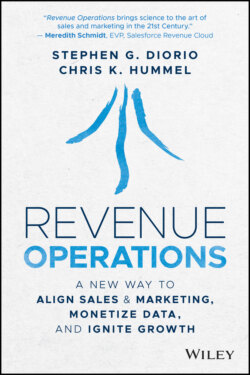Читать книгу Revenue Operations - Stephen Diorio, Chris K. Hummel - Страница 12
Service: Progressive Emergence
ОглавлениеIn the context we use for this book, service drives the customer's consumption of your product or service. This function covers activities like onboarding, activation, implementation, support, adoption, change orders, upgrades, maintenance, and many more. In most cases, these responsibilities are distributed across multiple organizations with many labels such as customer care or field service. Occasionally, the role is so important that a company will bundle many of these responsibilities into a branded, differentiated service offering like Apple's Genius Bar and BestBuy's Geek Squad.
“Service” isn't really one function but rather an amalgamation of roles from a variety of other organizations. This minimizes the institutional authority of service, even though the product consumption experience has become one of the most important factors in growing lifetime customer value. Cloud software companies do often have a function called “Customer Success” that handles much of the adoption process for complex offerings, and this function is starting to pop up in other industries that have complex implementation requirements.
The role of service has been elevated as it now commands a rising share of the customer interactions in the business, play a bigger role in revenue growth and relationship expansion, and have more direct control over the primary objectives of the business: namely, growing customer relations' lifetime value and net recurring revenue.
The “service” function doesn't exist as one entity. The product consumption experience is rarely managed inside one internal organization but is rather fragmented across regional, product, sales, marketing, and other teams with little rhyme or reason.
Service rarely has a seat at the executive table. Since service usually doesn't exist as a single organizational entity, it lacks institutional authority as a “constituency” and feels the absence of a c-level leader to advocate for and allocate resources to improving the customer ownership experience.
Driving product adoption has become more important to revenue expansion. Customer loyalty is critical to revenue expansion. First, customers are more focused on time to value and want faster returns on their assets and investments, so they buy in smaller, bite-size, iterative chunks. Second, subscription models also simplify the customer's ability to cancel the service, so the selling of value never stops.
Subscription business models are becoming the norm. Subscription models where the customer pays a scheduled usage fee per agreed-on period have become very popular. Such annuity revenue streams are very attractive and have penetrated many sectors as either rental- or performance-based fee models. How to transform one's portfolio into a subscription model is one of the core questions we hear from many companies.
The customer success function is moving beyond software as a service (SaaS) companies as people recognize its value add. Cloud companies natively understand the value of the customer ownership experience and have been pioneers in setting up “customer success” teams that manage the onboarding, activation, and training of new customers. That concept of a customer success function has migrated into many other industrial and technology businesses as a best practice.
Service leaders come from many different backgrounds – often project management – and hold many different titles. Yet the access to customer intelligence in this “function” rivals and maybe even beats marketing's data sets. This is a new, emerging space on the org chart that is worth watching.
The three teams work hard and do their best, but somehow things just aren't clicking.
Stepping back into the CEO shoes, there are common observations from all the functions.
Change is everywhere: Not only does change scare people, but it raises questions about whether the benefits of transformation are worth the pain.
Real-world problems are interdependent and interdisciplinary: Regardless of what its org chart looks like, any business needs to manage the entire revenue cycle as an integrated whole before, during, and after the transaction.
A systems-based approach is required: Consistency, repeatability, and automation help ensure that good performance is sustainable over time and scalable.
